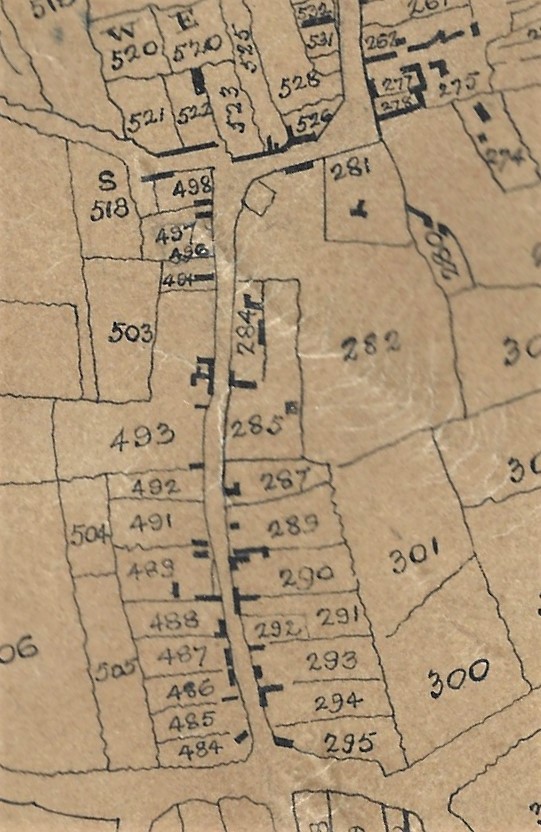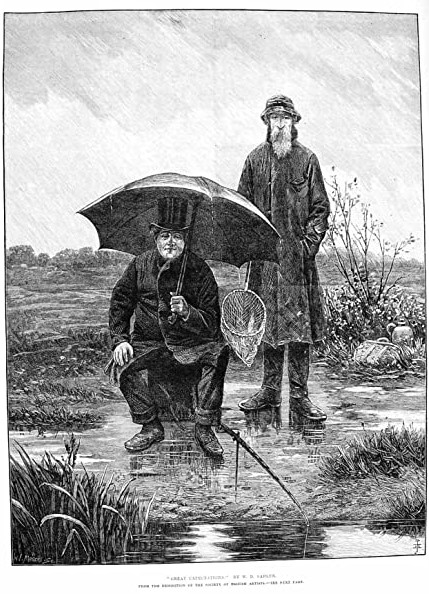We are now at the southern end of South Street (on its west side). On the Enclosure Map of 1798 this would place us at Plots 484/485/486
A section of William Gauntley’s Enclosure Map 1798
According to Adeline “the next shop (after Widow Brown) was taken by Mr. Ralph Shaw, butcher. They had not any children. Mrs. Shaw attended the South Street Chapel”.
Adeline has made a slight mistake. It was Joseph Shaw who was the butcher of South Street not his older brother Ralph, who was a saddler and harness maker, living on the other side of the same street. When both Ralph and Joseph were young lads the name of their street wasn’t South Street but was known as Town Street; this stretched from the Toll Bar to the bottom of what was later Bath Street. Only about 1831 was Town Street divided into two parts — present-day Bath Street and South Street. The reason for this name change can be found here.
Both Ralph (born about 1805) and Joseph (born in 1817) were children of collar maker John and Mary (nee Wheatcroft) who had also lived in ‘South Street’. When John died in May 1823, in his will he left all his business assets to his wife who was to continue to organise the family trade, and to eldest son Ralph who was to take the more ‘active’ role in the same business ‘to the best of his ability‘. Therefore on the Ilkeston Trade Directories following John’s death we can find “saddler Mary Shaw” (Glover’s Directory of 1829; Pigot & Co’s Directory of 1829, of 1835 and of 1842).
Ralph Shaw also inherited his father’s dwelling house, barn, workshop and croft, which was on the east side of South Street at its corner with Nottingham Road (commonly called Toll Bar corner). There was a garden at the croft and Ralph was allotted a small part of this also. Within John’s estate was property within what was later called Robey Yard, and we shall examine this later.
Other children — John (born in 1810), Mary (born in 1814), Joseph (born in 1817) and William (born in 1819) — were also mentioned in the will and provided for out of John’s estate at Little Hallam. All of them were young children in 1823, the year that John made his will.
This left one child, Elizabeth (born in 1812), also mentioned in the will and who was to be provided for by her grandfather. She had a mental disability and was unkindly described elsewhere as an ‘imbecile’. (She died on November 15th 1845).
——————————————————————————————————————————–
Joseph Shaw married Mary Riley, daughter of framework knitter John and Jane (nee Walker) on May 30th, 1849 and there were no children in the family.
In December 1863 great interest was aroused in the town when Joseph found himself in a foot race with Samuel Pounder, assistant surveyor of highways and about ten years his junior. Joseph was light and long-legged while Samuel was shorter, more robust, and had recently broken his leg.
No contest then ?!
Bets were laid — including one between the two participants — and the race began. Seven laps of the Cricket Ground were followed by a run to the Exchange in Nottingham and then back to the Market Place in Ilkeston.
Samuel returned well ahead. ‘Poor Joe’ had to be ‘carted home most of the way’; he was about 45 years old at the time.
Joseph died on March 5th, 1872, aged 55.
——————————————————————————————————————-
Fishing Match: Tunnicliffe vs Singleton.
The people of Ilkeston seem to have been extremely keen on races, boxing matches, shooting or fishing contests and animal coursing.
In 1864 the Pioneer reflected upon this interest.
“A race! Whether rabbit, dog, man, or donkey race, has a magic influence on the minds of Ilkestonians. Announce it one hour, and the next, thousands will flock to the scene of the sport. No sensations at the chapels, schools or music-halls can equal it. Anyone wishing to lecture the people of Ilkeston on intemperance, or any of the sins they love, could not draw an audience with more success than by announcing ‘A race’!”
In 1872 a considerable number of spectators wandered down to Green’s Pond, part of the Erewash Canal ending at Gallows Inn Lock, to witness and ‘speculate on’ a fishing match between coalminers Henry Tunnicliffe of Ilkeston and Jonas Singleton of Marlpool.
The first cast was at 10am and five hours later, at the end of the contest, Henry had landed precisely one fish, weighing half an ounce. As this was one more than his opponent he was declared the winner and pocketed the side bet of £2 10s.
The Ilkeston Telegraph reported that “this magnificent specimen of the finny tribe has been sent to Nottingham to be stuffed and will be kept by his captor as a memento of his good luck”.
A few weeks later and the angling couple had moved a short distance along the Canal — to the head of the pond that ended at White House Lock, near Severn’s Bridge — for a ‘return match’.
About 200 spectators saw another Tunnicliffe victory.
——————————————————————————————————————-
And the last shop on this side was owned by William Sanders.



